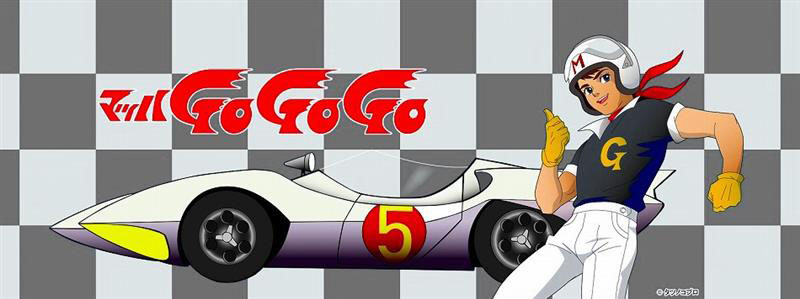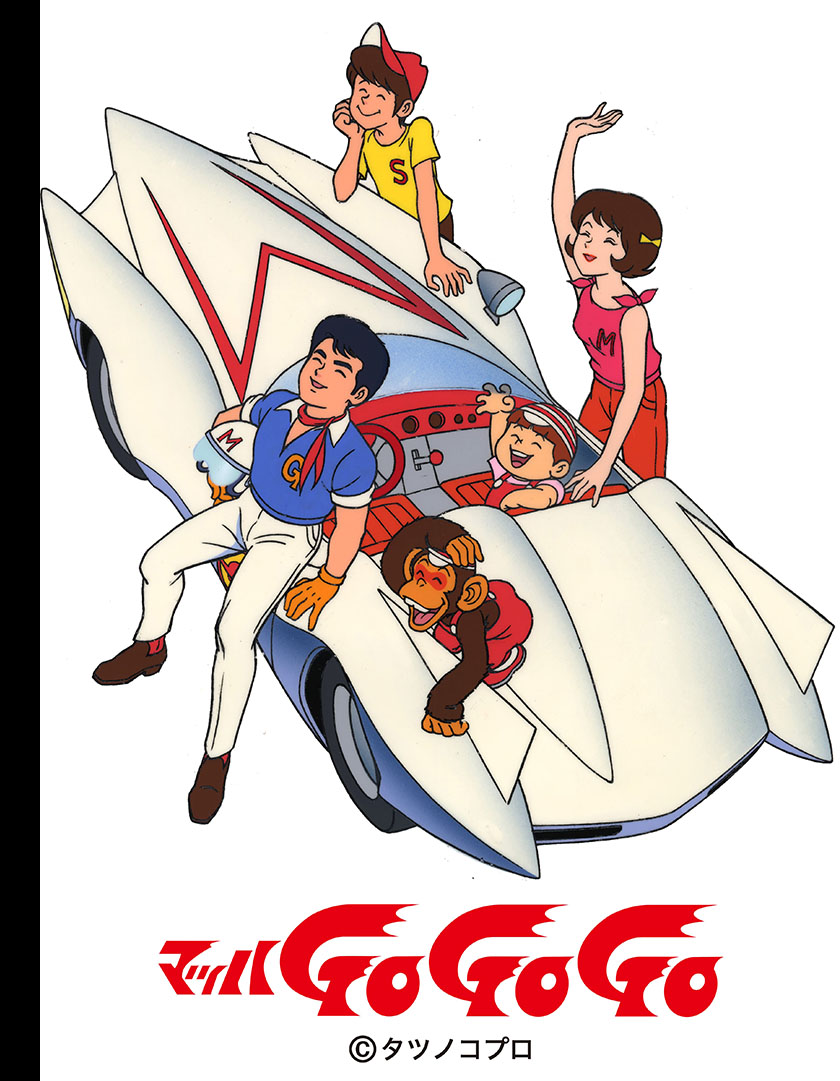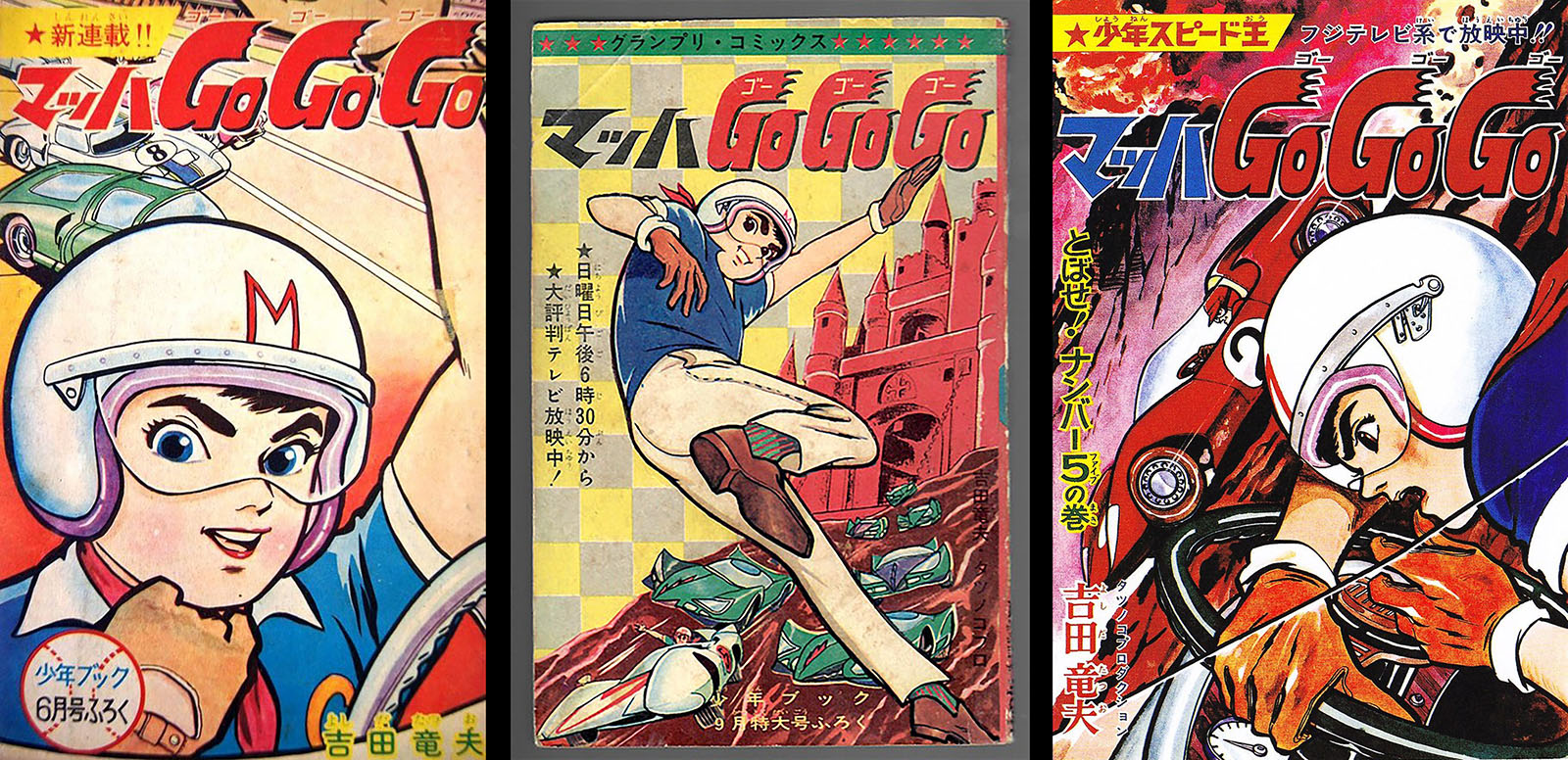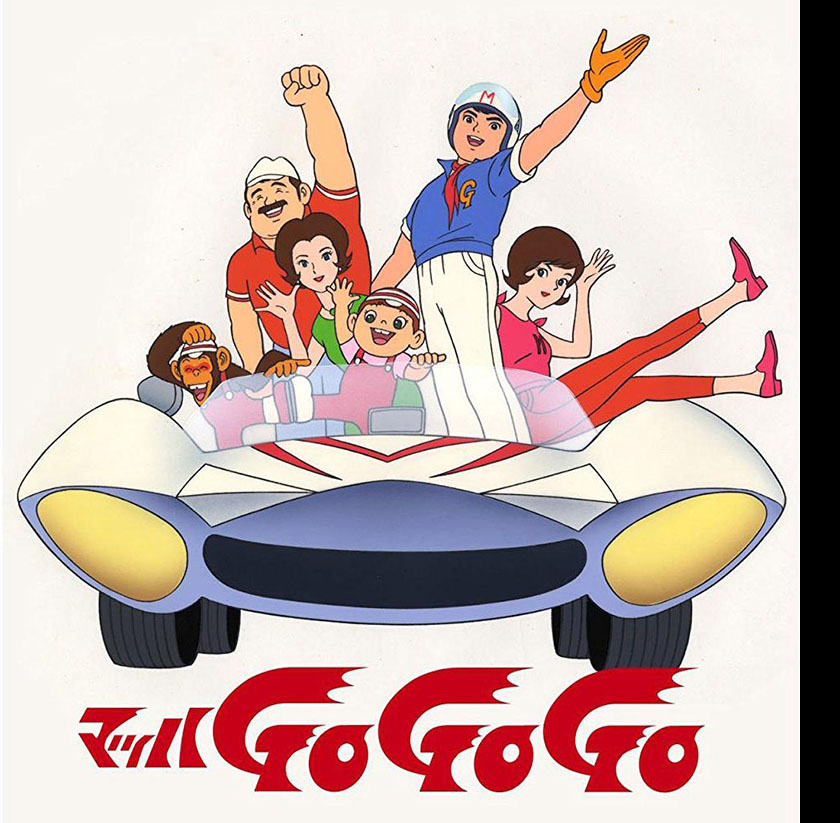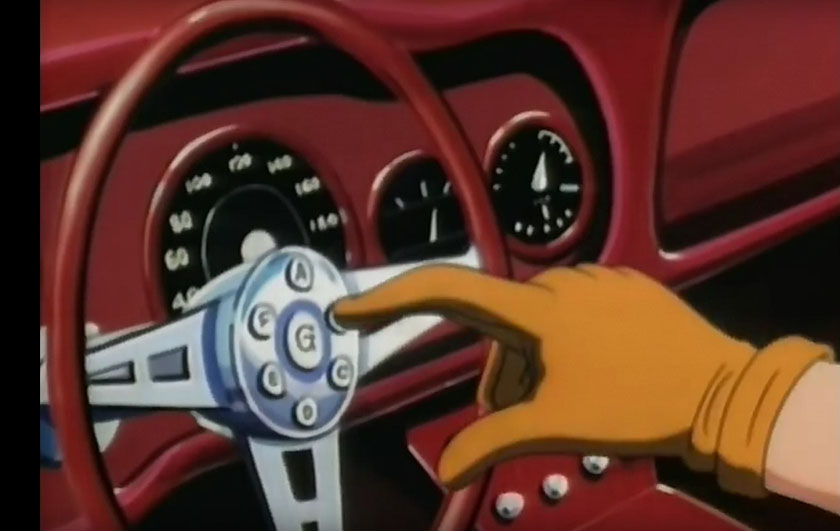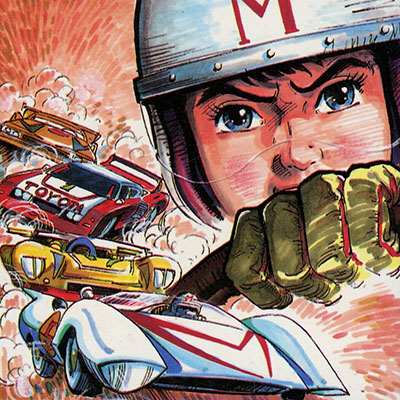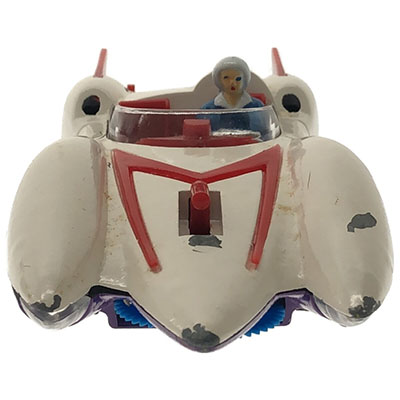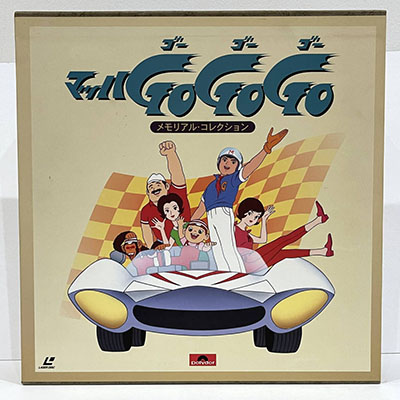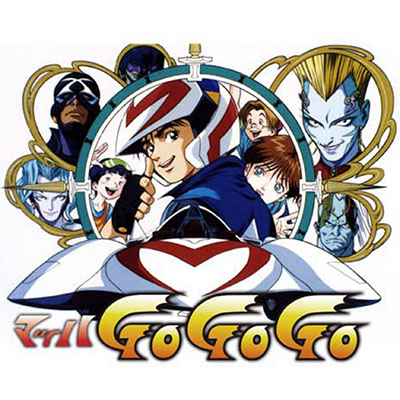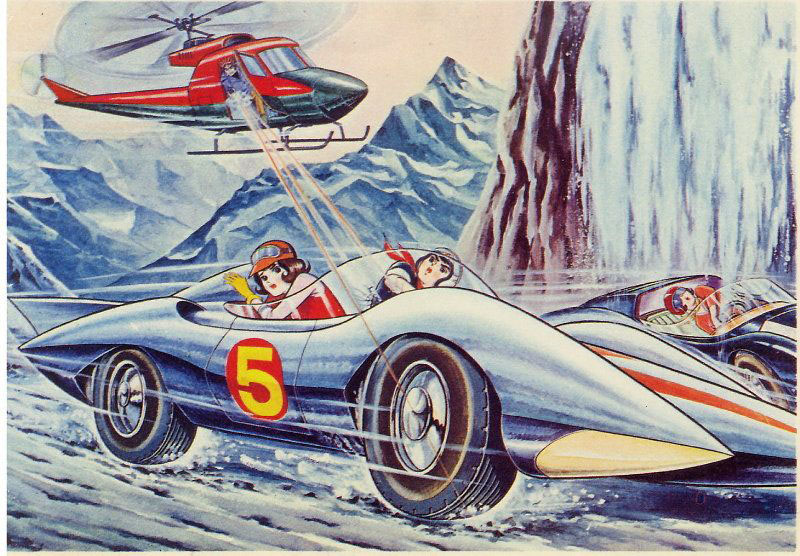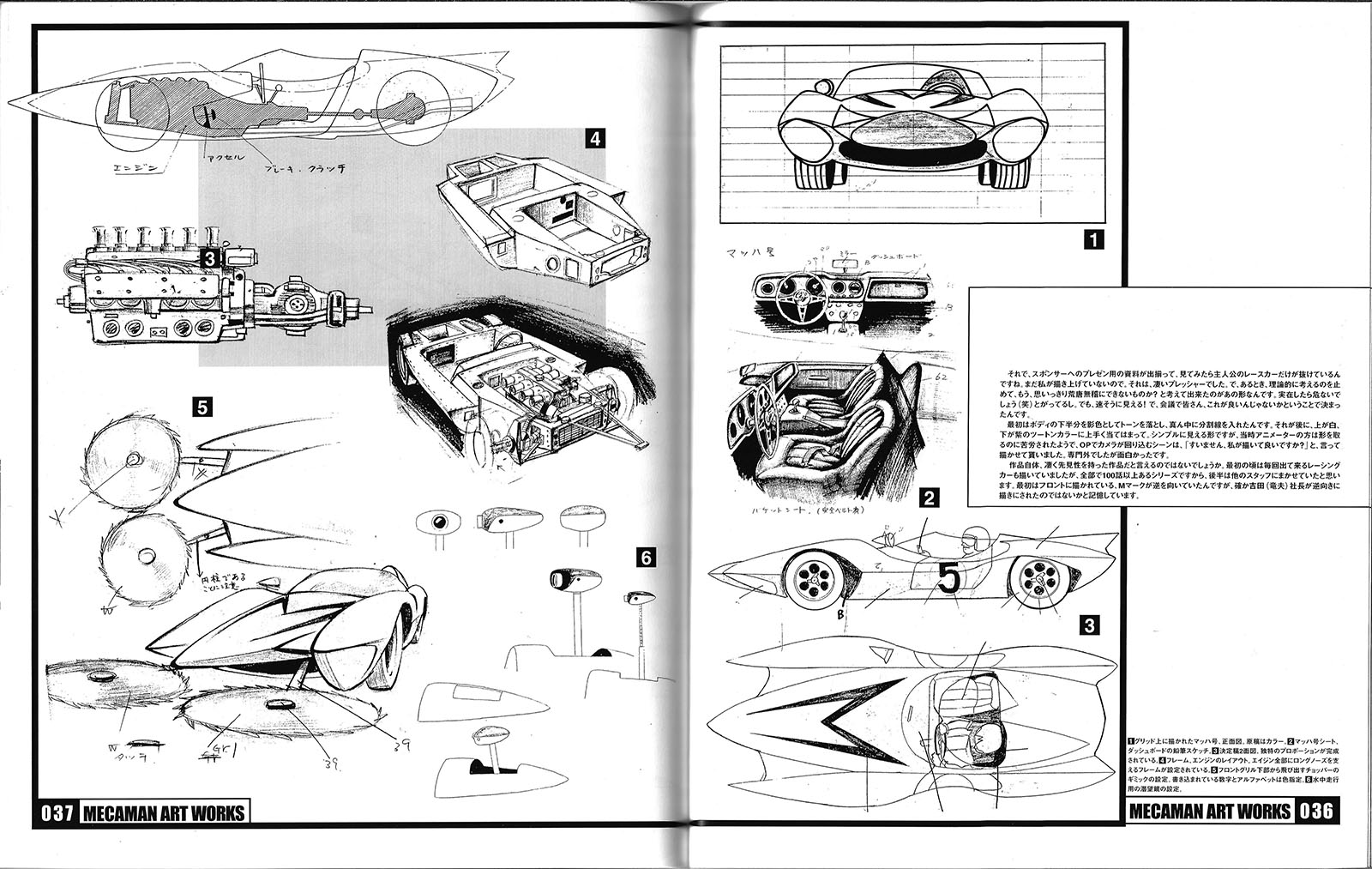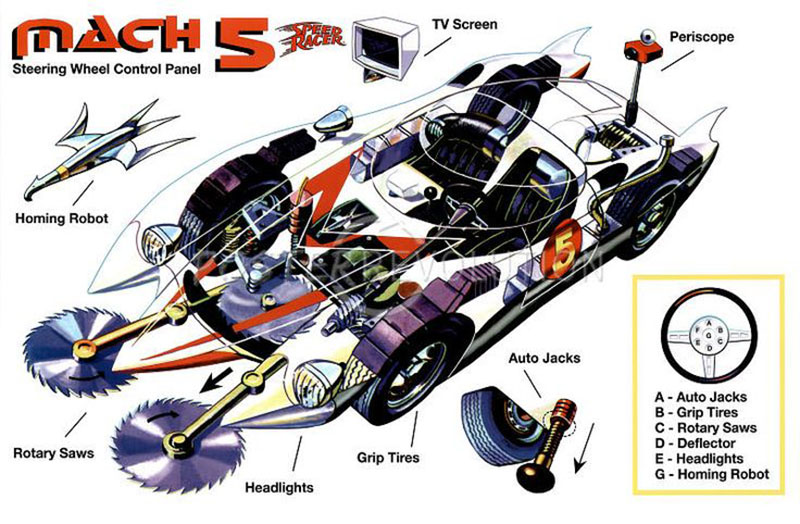Series profile: Mach GoGoGo, 1967
It was almost exactly 50 years ago as I write these words. I was a boy of eight in the summer of 1973. We took a family trip to West Palm Beach Florida, where my grandmother was living at the time. To this day, here’s the only thing I can remember from that trip: one afternoon, sitting in my grandmother’s apartment, I watched a cartoon I’d never seen before. Everything about it commanded my attention. A young guy named Speed Racer drove the coolest car I’d ever seen in my life, yet he was angry that he was losing his edge to another driver who could make turns on two wheels. His frustration was tearing his team apart.
The rest of that trip has been lost to memory fog, but I never forgot what it was like to see that show for the first time. I’d been watching cartoons my whole life, of course, but this one was entirely different from Saturday morning fare. A visual world full of drama and energy that electrified me in ways others did not. Everything about it inspired me. Without knowing it, I had just seen my first anime. (Before we even had the word “anime.”)
It was also a lesson to to me that TV wasn’t the same in every state. For some cruel and heartless reason, we didn’t get Speed Racer in Michigan. But a year or so later, the Mach 5 roared onto my own TV and I could watch Speed’s adventures every day after school. I immediately started drawing pictures of the characters – and that incredible car – and trying to recapture the magic in my own crude little comics. I worked out all the dimensions of the Mach 5 and Racer X’s car, later cobbling together my version of the Shooting Star for the Cub Scout pinewood derby. Whatever it took to keep that spirit alive between episodes. At any moment, that unforgettable theme song was running through my head. It’s still there today, residing in the same cache as my phone number and my daughter’s birthday.
This is what happens when you see something that was made for you at the exact age you’re meant to see it. It becomes imprinted, a companion that will travel with you for the rest of your life. When I finally learned what anime was in 1980 (thanks to Star Blazers), I was delighted to find out that I’d already gotten my introduction in the best way possible.
There’s no shortage of Speed Racer content available online these days. If you’d like an overview of its fortunes, Wikipedia and Let’s Anime has you covered. So rather than retread those tires, I’m going to auto-jack this hotrod onto a completely different track and go back to the original. Sing it with me now: Maha go! GO! GOOOOOOO!
As soon as I mastered the art of spelunking through Japanese websites, I pasted マッハGOGOGO into my search bar (and マッハ ゴー ゴー ゴー for good measure) to see what would emerge from the cobwebs. This practice has taught me to expect the unexpected, and I was not disappointed.
Pilot Ace
Ace driver Eiichi Yamada fights rivals who appear one after another in life-threatening races. At the beginning of his story, he enters a race in his beloved car, the Ace, to earn money for his father (a space rocket developer) to pay for his research. However, the race is cancelled due to interference by spies who are after the blueprints of Dr. Yamada’s rocket.
Eiichi takes on the challenge of another race, but his father’s rival Dr. Onimura, his racer son Motozo, and the mysterious motorcyling spy No. 13 stand in his way.
In a later story called The Curse of the Inca, Eiichi is challenged by an unidentified racer to participate in a grueling race to the death, which takes place on an underground volcanic road in South America. The race then moves further into the war-torn Arab world.
Pilot Ace was a hugely popular manga serialized in Shonen Gaho magazine from 1960 to 1964. We all thought Elvis was the inspiration for Speed Racer (just take a look at him in the 1966 movie Spinout below), but the true source was much closer to home. How did Mach GoGoGo get away with being such an obvious echo of Pilot Ace? Simple: both were created by the same artist, Tatsuo Yoshida.
Mach GoGoGo overview
from the Tatsunoko Pro Anniversary book, 1993
Historical context: in 1966, Nissan Motor Co. was newly established amidst a series of aircraft accidents. Traffic wars were declared, and in April 1967, “Traffic 110” was established (the equivalent of the American 911 emergency number). In May, Toyo Kogyo announced the Cosmo Sport, which put rotary engines to practical use. In June, the number of automobiles on the road exceeded 10 million, ushering in the “rent-a-car” boom. Traffic accidents were becoming more frequent, and people’s attention was focused on land rather than air, and on automobiles.
Tatsunoko Pro, which made its mark with Space Ace, presented its second TV series with a unique color tone and art style. Creator Tatsuo Yoshida’s touch was utilized to create a realistic gekiga style that was unparalleled at the time. It was also full of the sharp action scenes that would later become Tatsunoko’s specialty.
The basic concept is that the main character, Go Mifune, travels around the world on adventures in the Mach, a fascinating super machine that far predated the supercar boom. This became the basis for the style seen in later Tatsunoko works. While the protagonist of Space Ace was an orphan, here Go’s family participates in his adventures while his older brother Kenichi, a genius racer, is missing. Here again, the family ties are harmonized.
Go races in a prototype white racing machine, named the Mach. He is a hot-blooded boy who, like his parents, cannot back down once he starts driving! The Mach, developed by his father Daisuke, the president of Mifune Motor Co, is a super machine with 8 special abilities. It can go underwater with its cockpit sealed up, cut down trees with two rotary saws to race through forests, jump with an auto-jack, and advance in the dark with an infrared light.
Using the hidden powers of this super machine to the fullest, Go rushes around the world watched over by his family, his girlfriend, and a mysterious masked racer. Go Mifune and his Mach face many tough races and conspiracies of criminal organizations, while he matures as a racer.
Explanation of Mach GoGoGo
by Hiroshi Tsunemi (from the Round 1 OST CD, 2002)
Go Mifune is a boy who travels around the world in his beloved car “Mach,” aiming to become a first-class pro racer. Mach GoGoGo is a race action anime with a realistic touch and a sense of speed.
Japanese TV animation started with Tetsuwan Atom in 1963. Once the sci-fi boom of robots and space fiction died down in 1966, production companies began to try their hand at various genres in order to expand the possibilities. After Tatsunoko Productions debuted with its first work, Space Ace (1965), they produced Mach GoGoGo based on Tatsuo Yoshida’s manga Pilot Ace.
In Pilot Ace, the main character – Eiichi Yamada – aims to become a spaceship pilot. He was replaced by Go Mifune, whose car “Mach” was a greatly upgraded version of Eiichi’s beloved car “Ace.” This adds to the mechanic appeal of the story.
This was the second Tatsunoko Pro series, but also its first color production. In the early 60s, color TVs were still not widely used in homes, so the programs themselves were mostly in black and white. Color TV programs were usually marked with “color” on the TV sections of newspapers. The company went through various trial-and-error processes to solve color issues, then Mach GoGoGo was born.
The program was originally scheduled to be broadcast on Japan TV from October 1966, but it was eventually broadcast on Fuji TV the following year, starting in April. Fuji aired the program every Sunday night at 7:00 p.m. in competition with The Takeda Hour on TBS, which aired Ultraman and other programs. Starting with Episode 14, the airtime was moved up to 6:30 pm.
Needless to say, the mechanic appeal of the “Mach” is the main attraction of this work. The theme is car racing, but it is not limited to that. The story is full of original ideas that are unique to Tatsunoko Pro. The main character is surrounded by diverse personalities that expand the world of the work. It has a science-fiction setting, an international world, a mechanical appeal, spicy action, humor sprinkled here and there, and a family bond. The elements that would later become the basis for Tatsunoko works can be seen.
While other anime production companies at the time were trying to simplify animation with manga-like drawings. Tatsunoko Pro knew the difficulties involved, but they took on the challenge of creating more realistic gekiga-like drawings. The company succeeded in creating a unique character world and an expertise in mechanical drawing. It gives you the vital feeling of speed in the car races.
Mach GoGoGo was the second work of Tatsunoko Pro, but it was the very starting point of the studio. The popularity of this work was not limited to Japan, leading to Speed Racer, which is still popular around the world to this day.
Finally, I would like to mention the Mach’s special devices:
A: Autojack
B: Belt Tire
C: Chopper
D: Defenser
E: Evening Eye
F: Frogger
G: Gizmo-go
It is said that there are seven, but in Episode 6 a homing device is added to return to the Gizmo-go to the Mifune family. After that, the H button next to the remote control lever for the Gizmo is no longer seen. “Gizmo” is used here because it is pronounced “Gizmo” in the story.
The Chopper is referred to as the Cutter device in the introduction at the beginning of episodes 2, 26, and 38. Similarly, the Frogger is called a frog device.
Related links
The History of Speed Racer documentary
Series database at Anime News Network
In the years when I had full context for Speed Racer and Mach GoGoGo, I enjoyed watching it again for several reasons. Nostalgia had its say, but there was also recognition of its place as a pioneer in anime history. I had the pleasure of befriending its two principal voice actors, Peter Fernandez and Corrine Orr (read my posthumous tribute to Peter here) and later enjoying the hell out of the long-awaited live action movie in 2008, which as far as I’m concerned got it right in all the ways that mattered.
So what about all that glorious merch that accompanies a popular anime series? Surprisingly, there wasn’t as much of it as I thought in the early years. Back then, as mentioned earlier, the word “anime” didn’t exist when Mach GoGoGo first aired in 1967. Since most animated shows originated from manga, they were called “TV manga,” and uniformly considered to be children’s entertainment. Thus, the products were all aimed squarely at children who were expected to outgrow cartoons around age 10, so there wasn’t much variety to be found.
As time went on, however, Mach GoGoGo definitely got its due. Collected in these categories are all the Japanese products I could find, both old and new, with a few American items dropped in where appropriate. Then there’s the matter of the 1997 Mach GoGoGo anime reboot, which is truly a hidden gem. So start digging! Surprises await!
Origin of the Mach
Mecha Designer Mitsuki Nakamura
From Mecaman Art Works, 2001
Mach GoGoGo was an upgrade of the original racing manga Pilot Ace, drawn by Tatsuo Yoshida and Ippei Kuri. However, we decided to make the main character’s mecha new and innovative. I was in charge of art at the time, and I guess I was chosen.
I drew hundreds of sketches. I had a hard time coming up with a good idea for the car. The functions of the car were developed by the writing department, but there was nothing about the form or shape.
When presentation materials for the sponsor’s presentation were prepared, only the main character’s race car was missing. I hadn’t finished it yet. That was a lot of pressure. And then one day, I stopped thinking theoretically.
I thought, “Can’t I make it as wild as possible?” And that’s how I came up with that shape. It would be dangerous if it really existed (laughs). But it looks fast! At the meeting, everyone agreed that this was a good idea.
At first, the lower half of the body was toned down to a shadow color, and a dividing line was placed in the middle. Later, I decided to use a two-tone color, white on top and purple on the bottom, and it worked well. It looks simple, but the animators at the time had a hard time getting the shape right,
For the scene where the camera goes around it in the opening title, I asked, “Excuse me, can I draw it?” And they let me. It was not my specialty, but it was interesting.
I think it can be said that this was a visionary work. In the beginning, I drew the racing cars that appeared in the episodes, but I left the latter half of the series to other staff. At first, the M mark on the front was facing the opposite way. I remember that Tatsuo Yoshida turned it around to face the other way.
Tatsunoko anime in me
By Industrial Designer Jun Okafuji, from the Tatsunoko Pro Anniversary book, 1993
The “Mach” was an inspiration
Let’s reminisce on the historical background of the time when Mach GoGoGo was produced.
At that time, Japan was in the midst of motorization, with everyone taking an interest in cars. The number of cars owned surpassed 10 million, and a race to develop domestically-produced sports cars was underway. The completion of the Fuji speedway brought a boom in racing.
Many young people were attracted to the Toyota 2000GT, Nissan Fairlady, and Honda Sport. Porsche and Lotus were the envy of the circuits. At that time, the Guardian was free and original. American cars were escaping the flamboyant and overdecorated look of the late 50’s, turning low and stylish. It was also around this time that so-called “dream cars” began to appear.
It was against this backdrop that Mach GoGoGo was launched. The series was a sampler that attempted a number of expressions that had not been used in TV anime up to that time. It was designed with color TV in mind. A shading effect by airbrush was often used to express a metallic feeling with the reflection of chrome plating, the curved surface contours of the car body, and so on.
Artist unknown
The opening title was the first step in the composition of the work, which broke away from a “moving manga” look to true “video.” (At the time, it was called “TV manga” rather than “anime.”) The opening drumbeat alone distinguished the work from other TV manga, and the “Mach” jumps off the track to create a nimble wipe, changing scenes to run through Savannah, caves, and across the desert at sunset.
The heroes of TV manga are the only ones on Earth, maybe even the whole universe, dressed in costumes as they battle their greatest enemies. But Go wears a one-point shirt with his initial on it. He goes out for a drive with his girlfriend Michi. (Who also wears a shirt with her initial on it!) Go’s young and beautiful mother looks like she stepped out of a Hanna-Barbera cartoon. The Masked Racer looks like he came from the American X-Men comic books. Everything was put together with a sense of style that transcended the TV manga of the time.
The symbol of this was the Mach.
Its greatest feature is its sexy and glamorous styling. Even the front nose, which is divided into three sections, is sci-fi-like. The air intake under the nose is reminiscent of a jet fighter. The low and long nose and the receding windshield form a well-proportioned form as a whole. The two vertical tail plates on the rear fenders and the cooling air intake cutouts on the body sides are reminiscent of a jet fighter, sufficient to create a sense of speed. Also, it seems that a small fin is attached between the three divided noses, either by design or for drawing purposes.
The characteristic shaped fender arch and the round 5-hole wheel were ahead of their time, created before M. Gandini at Bertone (Carrozzeria in Italy) designed the Lamborghini Countache in 1970! The compact engine was mounted in the front, and the cockpit was a practical 2-seater. It also had a trunk to store spare tires.
Artist unknown
It had a white body with a crimson “M” mark, and No. 5 on the body sides with a Japanese flag base. The lower half of the body was painted in a midnight purple, and the bright red interior, which reminds us of American cars of the time, gives us a good sense of color.
The car also has seven special functions hidden in the body, A → Auto jack, B → Belt tire, and so on. The seven special functions are abbreviated by initials A to G, and are made to function with the simple touch of a button. Among them, Autojack (A), Frogger (F), and Gizmo (G) are the most impressive.
Autojack is the most frequently used function in the story. The idea of having the jack jump by activating it while the car is running was a wonderfully convincing setup for boys, anyway.
The Frogger (F) has a hard top made of fiberglass to seal the cockpit. Pressurized air is pumped into the cockpit and engine to enable underwater travel. The periscope extends and the mirror becomes a monitor! This was long before 007 drove the Lotus Esprit underwater.
The seven buttons from A to G are functionally and centrally located in the center of the steering wheel. This was the most ergonomically convenient position, the same layout that J. Giugiaro (who designed Maserati Ghibli, VW-Golf, Nikon – F3, Seiko speed master, etc.) tried with many prototype cars around 1980!
Art by Matthew Cushman
The image base of the Mach is probably the “Corvette SS” designed by B. Mitchell, which was presented at GM at the end of the 1950s.
In recent years, Japanese product design has been dominated by similar products that make you think, “I’ve seen this somewhere before.” Every car has an Ultraman face, and there is no such thing as a unique personality. This is said to be the result of the pursuit of air resistance. There is no need for the shape of front grills and tail lamps to lose their originality.
This is not limited to cars. AV equipment and home appliances are black, rectangular boxes. The streets are flooded with impersonal products that have no individual expressions.
The “Mach” is, of course, fictional. However, if we share the common goal of creating something original, it is precisely in these times that we should look back to the 1960s, when many dream cars were produced. Boys (or boyish adults) are always waiting for “something new and never before seen.”
For me, Mach GoGoGo and the “Mach” were my first experience of “fiction that soared with reality.” Above all, they were full of originality. Whether in anime or industrial design, it is the creation of something new, something that no one has ever seen before, that moves people. In other words, the “Mach” was an inspiration in itself.
Illustrated by Atushi Okafuji

